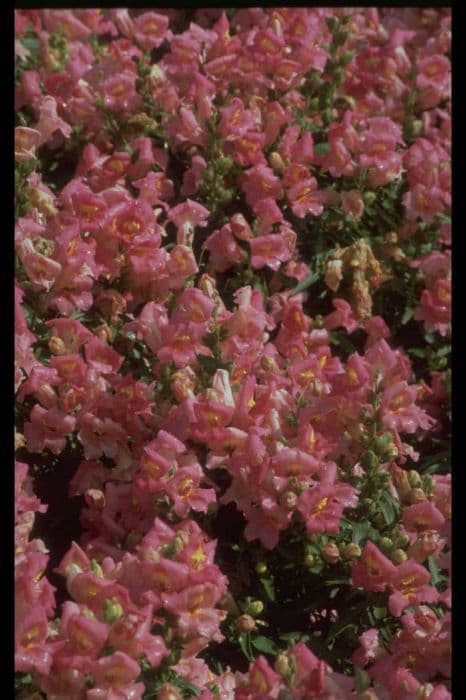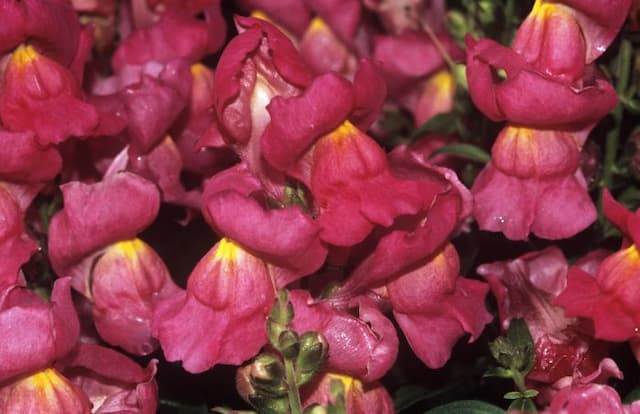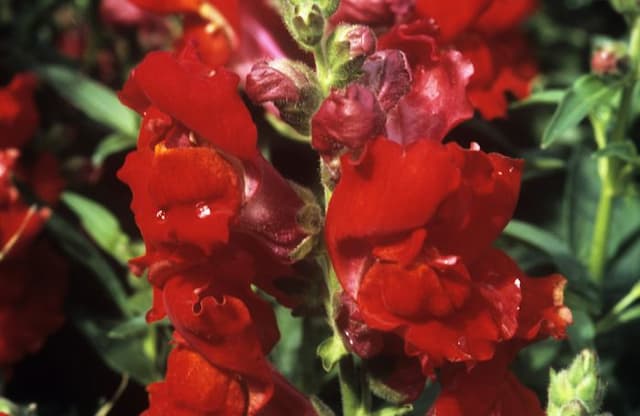Shrubby veronica Hebe 'Blue Clouds'

ABOUT
Hebe 'Blue Clouds' is a charming, evergreen shrub known for its decorative foliage and attractive flowers. The plant itself forms a compact, rounded shape with dense, lush growth. Its foliage consists of small, spear-shaped leaves that are arranged neatly along the stems. These leaves often have a fine, pale edge, giving them a delicate outline that contrasts beautifully with their darker green centers. The show-stoppers of this plant are the blooms it produces. During its flowering season, Hebe 'Blue Clouds' becomes adorned with spikes of small, trumpet-shaped flowers. These blossoms typically display an arresting shade of light blue to violet, creating a cloud-like effect above the greenery, thus inspiring the name 'Blue Clouds.' The flowers are often tightly packed on the upright spikes, making them stand out against the foliage. The blooms are known to attract various pollinators, adding an extra layer of liveliness to the plant as bees and butterflies frequent its flowers. Hebe 'Blue Clouds', with its combination of ornamental leaves and captivating flowers, makes an eye-catching specimen in any garden setting, offering a splash of color and texture to the landscape.
About this plant
 Names
NamesFamily
Plantaginaceae
Synonyms
Shrubby Veronica, Hebe
Common names
Hebe 'Blue Clouds'.
 Toxicity
ToxicityTo humans
Generally, the Hebe species, commonly known as Veronica, is not considered highly toxic to humans. However, as with many plants, some individuals may have sensitivity or reactions to the plant that are not widespread. Symptoms of plant poisoning can vary widely but typically may include gastrointestinal upset such as nausea, vomiting, or diarrhea if ingested in significant quantities. As a precaution, it is advisable to avoid ingestion of any part of the Hebe 'Blue Clouds' and keep it away from children who might accidentally consume the plant parts.
To pets
Veronica is not commonly listed as a toxic plant to pets, which includes Hebe 'Blue Clouds'. Nevertheless, individual pets might have sensitivities or allergic reactions to plants that are not toxic to most. If a pet consumes part of a Veronica plant, they might experience mild gastrointestinal upset, such as vomiting or diarrhea. It is still a good practice to monitor your pets around any plants and prevent them from ingesting plant material to safeguard against potential negative reactions.
 Characteristics
CharacteristicsLife cycle
Perennials
Foliage type
Evergreen
Color of leaves
Green
Flower color
Lavender blue
Height
2-3 feet (0.6-0.9 meters)
Spread
2-3 feet (0.6-0.9 meters)
Plant type
Shrub
Hardiness zones
8
Native area
New Zealand
Benefits
 General Benefits
General Benefits- Ornamental Appeal: Hebe 'Blue Clouds' offers striking foliage and beautiful lilac-blue flowers that enhance the visual appeal of gardens and landscapes.
- Low Maintenance: This plant is known for requiring minimal care, making it ideal for gardeners of all skill levels.
- Drought Tolerance: Once established, it is relatively drought-resistant, reducing the need for frequent watering.
- Attracts Wildlife: The flowers of Hebe 'Blue Clouds' attract pollinators such as bees and butterflies, promoting biodiversity.
- Versatile Planting: It can be used in various garden settings, including borders, containers, and as groundcover, offering flexible design options.
- Compact Size: The plant has a compact growth habit, making it suitable for small gardens or limited spaces.
- Seasonal Interest: It provides year-round interest with its evergreen foliage and flowers blooming in late spring to early summer.
- Hardy Nature: Hebe 'Blue Clouds' is quite hardy and can withstand cooler temperatures, making it suitable for a range of climates.
 Medical Properties
Medical PropertiesThis plant is not used for medical purposes.
 Air-purifying Qualities
Air-purifying QualitiesThis plant is not specifically known for air purifying qualities.
 Other Uses
Other Uses- Miniature Hedge: Hebe 'Blue Clouds' can be used to create low, informal borders or miniature hedges in garden settings due to its compact growth habit.
- Rock Gardens: The plant's ability to grow in a variety of soil types makes it an ideal addition for adding a touch of color to rock gardens.
- Seaside Landscapes: Being tolerant of coastal conditions, it's well-suited for seaside gardens where other plants might struggle.
- Dye Production: The flowers and leaves might be used for natural dye production, although not commonly practiced.
- Container Planting: Its small size makes it perfect for container gardening, where it can be positioned for optimal aesthetic value.
- Crafts and Flower Arranging: The flowers and foliage can be used in floral arrangements or crafts, providing a unique, textured addition.
- Erosion Control: Planting Hebe 'Blue Clouds' on slopes can aid in soil stabilization and prevent erosion due to its root system.
- Wildlife Garden: It can be included in gardens designed to attract butterflies and bees, as it is a good source of nectar.
- Landscape Accent: Their blue-purple flowers and evergreen foliage make them excellent accent plants in mixed beds and borders.
- Theatrical Props and Set Design: Its distinctive appearance makes it suitable for use as part of the decor in theatrical sets or photo shoots.
Interesting Facts
 Feng Shui
Feng ShuiThe Hebe plant is not used in Feng Shui practice.
 Zodiac Sign Compitability
Zodiac Sign CompitabilityThe Hebe plant is not used in astrology practice.
 Plant Symbolism
Plant Symbolism- Endurance: Named after the Greek goddess Hebe, the goddess of youth, Hebe plants generally symbolize durability and resilience, as they are hardy and can withstand various conditions.
- Youth: Since Hebe was the goddess who served nectar to the Olympians to give them eternal youth, Hebe 'Blue Clouds' is often associated with youthfulness and rejuvenation.
- Vitality: The lush green foliage and vibrant flowers of this plant represent life and vibrant energy, making it a symbol of vitality.
- Harmony: The soothing blue hues of 'Blue Clouds' flowers can symbolize peace and tranquility, evoking a sense of balance and harmony in the environment where it's placed.
 Water
WaterHebe 'Blue Clouds', commonly known as Shrubby Veronica, should be watered thoroughly, allowing the top inch of soil to dry out before the next watering. This typically means watering every week, but the frequency may need to be increased during hot, dry periods to maintain consistent soil moisture. Shrubby Veronica prefers receiving approximately 1 gallon of water each time for a medium-sized plant, to ensure the root zone is well-hydrated. Over-watering or allowing the plant to sit in water can lead to root rot, so ensure proper drainage. In winter, reduce watering to every other week, or as needed, to match the plant's reduced growth and water requirements.
 Light
LightShrubby Veronica thrives in full sun to partial shade. The ideal spot for this plant is where it can receive at least 6 hours of direct sunlight per day. Though tolerant of light shade, too little light may lead to leggy growth and reduced flowering. Avoid placing it in deep shade or harsh, afternoon sun, which can stress the plant and burn its leaves.
 Temperature
TemperatureShrubby Veronica prefers moderate temperatures and can typically tolerate temperatures as low as 20 degrees Fahrenheit and as high as 80 degrees Fahrenheit. The optimal growing temperature range for this plant is between 50 and 70 degrees Fahrenheit. It is not very frost-tolerant, so it should be protected or brought indoors if temperatures are expected to plummet below 20 degrees Fahrenheit.
 Pruning
PruningShrubby Veronica should be pruned to maintain shape and encourage bushier growth. Pruning is best done in early spring before new growth begins. Remove any dead or damaged branches and up to one-third of older stems to promote rejuvenation. Thin out overcrowded branches to improve air circulation, which is crucial for reducing the risk of disease. Annual pruning also helps encourage more prolific blooming.
 Cleaning
CleaningAs needed
 Soil
SoilThe best soil mix for Hebe 'Blue Clouds' should be well-draining and contain a mixture of loam, peat, and sharp sand to ensure adequate drainage and aeration. The soil pH should be slightly acidic to neutral, ranging from 6.0 to 7.0.
 Repotting
RepottingHebe 'Blue Clouds' commonly known as Shrubby veronica, should be repotted every two to three years to refresh the soil and accommodate root growth. Repot in spring or early summer to allow the plant to establish in the new container before winter.
 Humidity & Misting
Humidity & MistingShrubby veronica thrives in moderate humidity levels but is quite adaptable and can tolerate the varying humidity levels typically found in home environments. There are no specific humidity requirements for this plant, but it is resistant to most humidity levels as long as other cultural needs are met.
 Suitable locations
Suitable locationsIndoor
Place Shrubby veronica near a sunny window with bright, indirect light.
Outdoor
Plant Shrubby veronica in well-draining soil, full sun to part shade.
Hardiness zone
Shrubby veronica, or Hebe 'Blue Clouds', is suitable for USDA zones 7-10.
 Life cycle
Life cycleHebe 'Blue Clouds', also commonly referred to as shrubby veronica, begins its life cycle with germination, where seeds sprout in moist, well-drained soil after exposure to the required chill period to break dormancy. It progresses to the vegetative stage as it develops roots, stems, and leaves, growing actively during the spring and summer months. As it enters the flowering stage, typically from early to mid-summer, the plant produces small blue to violet flowers that attract pollinators such as bees and butterflies. Following pollination, the flowers may develop into small capsules that contain seeds, thus leading to the reproductive stage where new seeds are dispersed, completing the life cycle. In appropriate conditions, Hebe 'Blue Clouds' can thrive for many years, reaching the maturity phase where it maintains its size and shape through seasonal growth and pruning. This evergreen shrub can face a decline phase as well, affected by factors like severe weather, pests, or diseases, which may lead to its eventual senescence and death.
 Propogation
PropogationPropogation time
Spring-Early Summer
Hebe 'Blue Clouds', commonly known as Hebe, can be propagated primarily through semi-hardwood cuttings. The most suitable time for taking cuttings is in late summer to early fall when the current year's growth has started to harden but is not yet fully mature. To propagate, a healthy shoot should be selected and a cutting of about 4 to 6 inches (10 to 15 centimeters) should be snipped just below a leaf node. The lower leaves are then stripped, leaving several leaves at the top of the cutting. The cut end can be dipped in rooting hormone to encourage root development, although this is not strictly necessary. The cutting should be planted in a well-draining potting mix and kept consistently moist but not waterlogged. Covering the cutting with a plastic bag or placing it in a propagator can help maintain high humidity and improve the chances of successful rooting.









